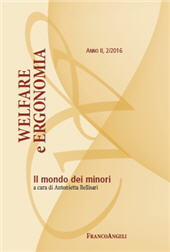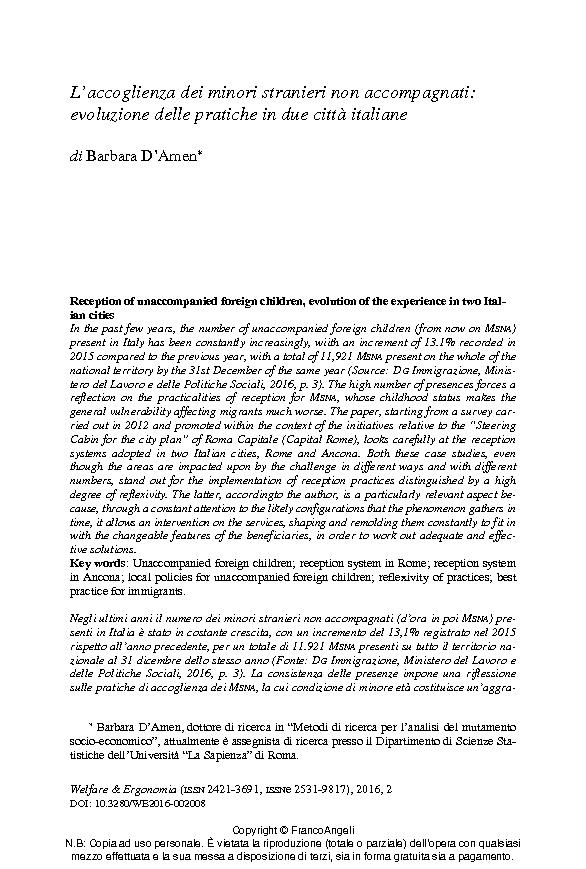2016 - Franco Angeli
Article
Digital Version
Download | Copy/paste | Printing
L'accoglienza dei minori stranieri non accompagnati : evoluzione delle pratiche in due città italiane
135-156 p.
- Negli ultimi anni il numero dei minori stranieri non accompagnati (d'ora in poi MSNA) presenti in Italia è stato in costante crescita, con un incremento del 13,1% registrato nel 2015 rispetto all'anno precedente, per un totale di 11.921 MSNA presenti su tutto il territorio nazionale al 31 dicembre dello stesso anno (Fonte: DG Immigrazione, Ministero del Lavoro e delle Politiche Sociali, 2016, p. 3). La consistenza delle presenze impone una riflessione sulle pratiche di accoglienza dei MSNA, la cui condizione di minore età costituisce un'aggravante dello stato di vulnerabilità che interessa i migranti in generale. L'articolo, partendo da una ricerca condotta nell'anno 2012 e promossa nell'ambito delle iniziative della "Cabina di regia per il piano cittadino" di Roma Capitale, propone una riflessione sul sistema di accoglienza attuato in due città italiane, Roma e Ancona. Entrambe queste realtà, seppur interessate dal fenomeno in modalità e proporzioni diverse, si sono distinte per la realizzazione di pratiche.
- di accoglienza caratterizzate da un elevato grado di riflessività. Quest'ultima, a parere dell'autrice, costituisce un aspetto particolarmente rilevante poiché, attraverso una costante attenzione alle possibili configurazioni che il fenomeno assume nel tempo, consente di intervenire sull'offerta dei servizi, plasmandola e riadattandola costantemente alle mutabili caratteristiche dei destinatari, al fine di elaborare soluzioni adeguate ed efficaci. [Testo dell'editore].
- In the past few years, the number of unaccompanied foreign children (from now on MSNA) present in Italy has been constantly increasingly, wiith an increment of 13.1% recorded in 2015 compared to the previous year, with a total of 11,921 MSNA present on the whole of the national territory by the 31st December of the same year (Source: DG Immigrazione, Ministero del Lavoro e delle Politiche Sociali, 2016, p. 3). The high number of presences forces a reflection on the practicalities of reception for MSNA, whose childhood status makes the general vulnerability affecting migrants much worse. The paper, starting from a survey car-ried out in 2012 and promoted within the context of the initiatives relative to the "Steering Cabin for the city plan" of Roma Capitale (Capital Rome), looks carefully at the reception systems adopted in two Italian cities, Rome and Ancona. Both these case studies, even though the areas are impacted upon by the challenge in different ways and with different numbers, stand out for the imple
- mentation of reception practices distinguished by a high degree of reflexivity. The latter, accordingto the author, is a particularly relevant aspect because, through a constant attention to the likely configurations that the phenomenon gathers in time, it allows an intervention on the services, shaping and remolding them constantly to fit in with the changeable features of the beneficiaries, in order to work out adequate and effective solutions. [Publishers' text].
Is part of
Welfare e ergonomia : II, 2, 2016-
Information
ISSN: 2531-9817
KEYWORDS
- Minori stranieri non accompagnati, sistema di accoglienza a Roma, sistema di accoglienza ad Ancona, politiche locali per i minori stranieri non accompagnati, riflessività delle pratiche, buone pratiche per gli immigrati
- Unaccompanied foreign children, reception system in Rome, reception system in Ancona, local policies for unaccompanied foreign children, reflexivity of practices, best practice for immigrants
-
In this issue
- Introduzione
- Adolescenza e ricerca dell'identità : la costruzione sociale del rischio tra narrazioni e pratiche
- La seconda socializzazione nella prima infanzia
- Con gli occhi dei bambini
- Famiglia e scuola, tutori di resilienza nel percorso adottivo
- Disabilità ed integrazione scolastica
- Minori migranti : nuovi protagonisti della mobilità contemporanea
- L'accoglienza dei minori stranieri non accompagnati : evoluzione delle pratiche in due città italiane
- Childhood condition in China
- I minori nella musica popolare : intervista a Nicoletta Salvi
- Abbreviazioni



